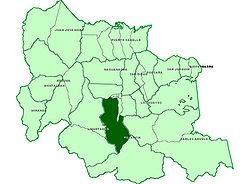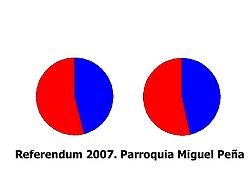
Miguel Peña
Encyclopedia
Miguel Peña is by far the largest civil parish in the municipality of Valencia, Carabobo
, and one of the most populous in Venezuela
.
It is located in the Southern part of the city and it has most of Valencia's poorest slum
s. It has a surface of some 200 km² for a density of some 2500 inhabitants per km².

(1781–1833), a well-known politician from Valencia who was active in the formation of Venezuela in the early part of the 19th century.
The parish has undergone a dramatic population growth in the last 40 years from internal immigration, particularly poor farmers coming from the South and from Caracas and immigration from other Latin American countries. Most people have come attracted by job opportunities linked to Valencia's industrial development.
It is one of the most dangerous regions in Carabobo
.
{|
| valign="top" |
{| class="wikitable"
! style="background:#efefef;" | Year
! style="background:#efefef;" | Population
|-
| 1990 || align="right" | 233.829
|-
| 1991 || align="right" | 246.057
|-
| 1992 || align="right" | 258.300
|-
| 1993 || align="right" | 270.525
|-
| 1994 || align="right" | 282.818
|-
| 1995 || align="right" | 295.189
|-
| 1996 || align="right" | 307.665
|-
| 1997 || align="right" | 320.297
|-
| 1998 || align="right" | 333.152
|-
| 1999 || align="right" | 346.265
|-
| 2000 || align="right" | 359.582
|-
| 2005 || align="right" | 428.831
|-
|}
Some urbanizations started to be built in the fifties and forties on the Northern part when Valencia started to become an industrial city. The main areas were Urbanización Mendoza, Urbanización El Palotal, Urbanización Ricardo Urriera and Urbanización Lomas de Funval. Some bridges were rebuilt giving access to Santa Rosa, El Boquete and Las Dos Bocas (currently the El Ahorcado bridge). There was almost no planning in the process.
The civil parish Miguel Peña was officially created by state law on 4 August 1971. Some avenues were built in the seventies, like the Aranzazu, the Sesquicentenaria , the Lisandro Alvarado and the Enrique Tejera avenues. Also a new road toward the South, to El Paíto, was made.
The chaotic urban expansion speeded up in the eighties and nineties, leading to a collapse of services and increased criminality.
and as such has little administrative independence. It belongs to the Municipality of Valencia. The governing body is a junta parroquial with relatively little powers.
There have been long discussions about making it an independent municipality, but this has not come to effect.
,
The area tends to vote for the Chávez system more than others in the region. In the referendum for the constitutional reform
of 2 December 2007, 53.95% of the voters there supported the reform against 40.78 for the whole municipality of Valencia
.

There are many other sectors that tend to be more precarious. Many of these areas lack services like electricity or proper water canalization.
Some of the main avenues are:

There are two main secondary schools: Liceo Zuloaga and Liceo Ponce Bello. There are also dozens of basic schools.
starts in this parish. The community has two underground stations:
Carabobo
Carabobo State is one of the 23 states of Venezuela, located in the north of the country, about two hours by car from Caracas. The capital city of this state is Valencia, which is also the country's main industrial center. The state's area is 4,650 km² and had an estimated population of...
, and one of the most populous in Venezuela
Venezuela
Venezuela , officially called the Bolivarian Republic of Venezuela , is a tropical country on the northern coast of South America. It borders Colombia to the west, Guyana to the east, and Brazil to the south...
.
It is located in the Southern part of the city and it has most of Valencia's poorest slum
Slum
A slum, as defined by United Nations agency UN-HABITAT, is a run-down area of a city characterized by substandard housing and squalor and lacking in tenure security. According to the United Nations, the percentage of urban dwellers living in slums decreased from 47 percent to 37 percent in the...
s. It has a surface of some 200 km² for a density of some 2500 inhabitants per km².

General
The area was named after Miguel PeñaMiguel Peña
Miguel Peña is by far the largest civil parish in the municipality of Valencia, Carabobo, and one of the most populous in Venezuela.It is located in the Southern part of the city and it has most of Valencia's poorest slums...
(1781–1833), a well-known politician from Valencia who was active in the formation of Venezuela in the early part of the 19th century.
The parish has undergone a dramatic population growth in the last 40 years from internal immigration, particularly poor farmers coming from the South and from Caracas and immigration from other Latin American countries. Most people have come attracted by job opportunities linked to Valencia's industrial development.
It is one of the most dangerous regions in Carabobo
Carabobo
Carabobo State is one of the 23 states of Venezuela, located in the north of the country, about two hours by car from Caracas. The capital city of this state is Valencia, which is also the country's main industrial center. The state's area is 4,650 km² and had an estimated population of...
.
Demographic growth
The following table shows part of the population growth of the last few years.{|
| valign="top" |
{| class="wikitable"
! style="background:#efefef;" | Year
! style="background:#efefef;" | Population
|-
| 1990 || align="right" | 233.829
|-
| 1991 || align="right" | 246.057
|-
| 1992 || align="right" | 258.300
|-
| 1993 || align="right" | 270.525
|-
| 1994 || align="right" | 282.818
|-
| 1995 || align="right" | 295.189
|-
| 1996 || align="right" | 307.665
|-
| 1997 || align="right" | 320.297
|-
| 1998 || align="right" | 333.152
|-
| 1999 || align="right" | 346.265
|-
| 2000 || align="right" | 359.582
|-
| 2005 || align="right" | 428.831
|-
|}
History
Around 1936 there was already a small settlement known as Cruz de Legua where now the Lomas de Funval urbanization is located. Still in the forties the area was used for farming. There were mainly large haciendas and some scattered houses where poor farmers lived.Some urbanizations started to be built in the fifties and forties on the Northern part when Valencia started to become an industrial city. The main areas were Urbanización Mendoza, Urbanización El Palotal, Urbanización Ricardo Urriera and Urbanización Lomas de Funval. Some bridges were rebuilt giving access to Santa Rosa, El Boquete and Las Dos Bocas (currently the El Ahorcado bridge). There was almost no planning in the process.
The civil parish Miguel Peña was officially created by state law on 4 August 1971. Some avenues were built in the seventies, like the Aranzazu, the Sesquicentenaria , the Lisandro Alvarado and the Enrique Tejera avenues. Also a new road toward the South, to El Paíto, was made.
The chaotic urban expansion speeded up in the eighties and nineties, leading to a collapse of services and increased criminality.
Administration and politics
Miguel Peña is a civil parishCivil parish
In England, a civil parish is a territorial designation and, where they are found, the lowest tier of local government below districts and counties...
and as such has little administrative independence. It belongs to the Municipality of Valencia. The governing body is a junta parroquial with relatively little powers.
There have been long discussions about making it an independent municipality, but this has not come to effect.
,
The area tends to vote for the Chávez system more than others in the region. In the referendum for the constitutional reform
Venezuelan constitutional referendum, 2007
A constitutional referendum was held in Venezuela on 2 December 2007 to amend 69 articles of the 1999 Constitution. Reform was needed, according to Venezuelan President Hugo Chávez, to implement his socialist agenda; detractors said he was using the reforms to become a dictator.The referendum was...
of 2 December 2007, 53.95% of the voters there supported the reform against 40.78 for the whole municipality of Valencia
Valencia Municipality
The Valencia Municipality is one of the 14 municipalities that makes up the Venezuelan state of Carabobo and, according to a 2007 population estimate by the National Institute of Statistics of Venezuela, the municipality has a population of 830,420...
.

Divisions
The region has grown without much planning. Some of the main areas are:- The Fundación Mendoza (Mendoza Foundation): This urbanization was financed by the Mendoza entrepreneur and was destined mainly for his workers.
- El Palotal urbanization: This is an urbanization built by the Banco Obrero (Worker's Bank) for the working class. Houses were assigned during Rómulo BetancourtRómulo BetancourtRómulo Ernesto Betancourt Bello , known as "The Father of Venezuelan Democracy", was President of Venezuela from 1945 to 1948 and again from 1959 to 1964, as well as leader of Accion Democratica, Venezuela's dominant political party in the 20th century...
's government mostly to people who had opposed the Marcos Pérez JiménezMarcos Pérez JiménezMarcos Evangelista Pérez Jiménez was a soldier and Presidents of Venezuela from 1952 to 1958.-Career:Marcos Evangelista Pérez Jiménez was born in Michelena, Táchira State. His father, Juan Pérez Bustamante, was a farmer; his mother, Adela Jiménez, a schoolteacher...
dictatorship. - La Antena
- Las Flores
- La Unidad
- Ruiz Pineda
- Santa Inés
- Barrio (Slum) La Victoria
There are many other sectors that tend to be more precarious. Many of these areas lack services like electricity or proper water canalization.
Some of the main avenues are:
- Avenida Las Ferias
- Avenida Lisandro Alvarado,
- Avenida Aranzazu
- Avenida la Romana
- Avenida Sesquicentenario
- Vía el Paito, which was built on the ancient Spanish road towards the town of Tocuyito and further to the Southwest.
Attractions
- Parque Recreacional del Sur

- Plaza de toros Monumental de ValenciaPlaza de toros Monumental de ValenciaPlaza de toros Monumental de Valencia is a bull ring in Valencia, Venezuela. It is currently used for bull fighting and other events like concerts and fairs. It is currently the second largest bullring in the world, the first being the Plaza de toros México. The stadium holds 25,000 people and was...
, part of the Parque Recreacional del Sur
Culture and education
There is a smaller public library, Miguel Colombet, at Calle Sucre cruce con Branger.There are two main secondary schools: Liceo Zuloaga and Liceo Ponce Bello. There are also dozens of basic schools.
Metro stations
Valencia's underground lineValencia Metro (Venezuela)
The Valencia Metro is the public mass transit system of Valencia, Carabobo, Venezuela and its suburbs Naguanagua Municipality and San Diego Municipality....
starts in this parish. The community has two underground stations:
- Estación La Monumental
- Estación Las Ferias.

